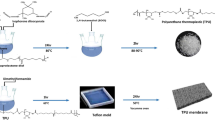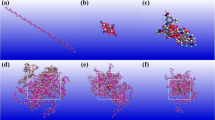Abstract
Trisilanolisobutyl polyhedral oligomeric silsesquioxane (TSI-POSS) with three hydroxyl functional groups pendent to an open cage, was incorporated in concentrations of 7, 13 and 22 wt% into 4,4′-methylenebis(phenyl isocyanate) and glycerol propoxylate to prepare TSI-POSS–PU hybrid composites as a heavy linking node in polymer backbone, respectively. These composites were characterized by FTIR, wide-angle X-ray scattering (WAXS), dynamic mechanical analysis and thermogravimetry techniques. In WAXS profiles, above 22 wt% TSI-POSS concentration, the morphology of composite is significantly altered and distinct crystallite clusters are formed, which increase the volume of hard segment in polyurethane (PU) hybrid composite. As TSI-POSS concentration rises, the glass transition temperature (T g) of composites is increased while the decomposition temperature is slightly decreased due to the oxysensitive isobutyl groups in structure. Meanwhile, the activation energy of hybrid composites is nearly unchanged indicating that the formation of crystallite cluster, which restricts motion of surrounding chains, is the predominant effect in T g increasing. It can be concluded that the morphology and the thermal property of polyurethane can be tailored by TSI-POSS incorporation, whereas functional group in TSI-POSS structure is the decisive factor for the thermostability of designed composites.






Similar content being viewed by others
References
POSS® User’s Guide version 2.06. Hybrid Plastics, Inc. http://www.hybridplastics.com/docs/user-v2.06.pdf. Accessed 15 April 2011
Scott DW (1946) Thermal rearrangement of branched-chain methylpolysiloxanes. J Am Chem Soc 68:356–358
Bonart R (1968) X-ray investigations concerning the physical structure of cross-linking in segmented urethane elastomers. J Macromol Sci Phys B 2(1):115–138
Koberstein JT, Leung LM (1992) Compression-molded polyurethane block copolymers. 2. Evaluation of microphase compositions. Macromolecules 25:6205–6213
Koberstein JT, Galambos AF, Leung LM (1992) Compression-molded polyurethane block copolymers. 1. Microdomain morphology and thermomechanical properties. Macromolecules 25:6195–6204
Lewicki James P, Hrley Stemphen J et al (2013) The influence of polyhedral oligomeric silsequioxanes on domain microstructure in polyurethane elastomers. Silicon 5:205–212
Fu Bruce X, Hsiao Benjamin S, Schwab Joseph et al (2000) Nanoscale reinforcement of polyhedral oligomeric silsesquioxane (POSS) in polyurethane elastomer. Polym Int 49:437–440
Oaten M, Choudhury NR (2005) Silsesquioxane-urethane hybrid for thin film applications. Macromolecules 38(15):6392–6401
Pistor V, de Cnto D et al (2012) Microstructure and crystallization kinetics of polyurethane thermoplastics containing trisilanol isobutyl POSS. J Nanomater doi:10.1155/2012/28031
Liu YR, Huang YD, Liu L (2006) Effects of trisilanolisobutyl-POSS on thermal stability of methylsilicon resin. Polym Degrad Stab 91(11):2731–2738
Montero B, Bellas R, Ramírez C, Rico M, Bouza R (2014) Flame retardancy and thermal stability of organic–inorganic hybrid resins based on polyhedral oligomeric silsesquioxanes and montmorillonite clay. Compos Part B Eng E 63:67–76
Song Lei, He Qingliang, Yuan Hu, Chen Hao, Liu Lei (2008) Study on thermal degradation and combustion behaviors of PC/POSS hybrids. Polym Degrad Stab 93(3):627–639
Weidner Steffen M, Trimpin Sarah (2008) Mass spectrometry of synthetic polymers. Anal Chem 80(12):4349–4361
Kun Wu, Song Lei, Yuan Hu, Hongdian Lu et al (2009) Synthesis and characterization of a functional polyhedral oligomeric silsesquioxane and its flame retardancy in epoxy resin. Prog Org Coat 65(4):490–497
Aman Ullah, Jenny Alongi, Saverio Russo (2011) Recent findings in (Ti)POSS-based polymer systems. Polym Bull 67:1169–1183
Madbouly Samy A, Otaigbe Joshua U (2009) Recent advances in synthesis, characterization and rheological properties of polyurethanes and POSS/polyurethane nanocomposites dispersions and films. Prog Polm Sci 24:1283–1332
Liang Kaiwen, Toghiani Hossein, Pittman Charles U Jr (2011) Synthesis, morphology and viscoelastic properties of epoxy/polyhedral oligomeric silsesquioxane (POSS) and epoxy/cyanate ester/POSS nanocomposites. J Inorg Organomet Polym 21:128–130
Yılmaz İnan Tülay, Ekrem Ekinci et al (2002) Preparation of novel UV-curable methacrylated urethane resins from a modified epoxy resin and isocyanatoethylmethacrylate (IEM). Polym Bull 47:437–444
Zheng Lei, Waddon Alan J, Bryan Coughlin E (2002) X-ray characterizations of polyethylene polyhedral oligomeric silsesquioxane copolymers. Macromol 35:2375–2379
Efrat T, Dodiuk H, Mccarthy S (2006) Nanotailoring of polyurethane adhesive by polyhedral oligomeric silsesquioxane (POSS). J Adhesion Sci Technol 20(12):1413–1415
Fu BX, Hsiao BS, Schwab J (2001) Structural development during deformation of polyurethane containing polyhedral oligomeric silsesquioxanes (POSS) molecules. Polym 42:599–602
Fedelich N et al (2013) Thermal analysis of Polymers. Mettler-Toledo AG. http://us.mt.com/dam/LabDiv/Campaigns/gp/gtap/thermal_analysis_of_polymers_en.pdf. Accessed 25 June 2014
Karbhari VM, Wang Q (2004) Multi-frequency dynamic mechanical thermal analysis of moisture uptake in E-glass/vinylester composites. Compos B Eng 35(4):299–304
Bai Yu, Jin Li (2008) Characterization of frequency-dependent glass transition temperature by Vogel-Fulcher relationship. J Phys D Appl Phys 41(5):152008. doi:10.1088/0022-3727/41/15/152008
Karbhari VM, Wang Q (2004) Multi-frequency dynamic thermal analysis of moisture uptake in E-glass/vinylester composites. Compos B 35(4):299–304
Li G, Lee-Sullivan P, Thring RW (2000) Determination of activation energy for glass transition of an epoxy adhesive using dynamic mechanical analysis. J Therm Anal Calorim 60(2):377–390
Thomas S, Valsaraj SV, Meera AP, Zsikov GE (2010) Recent advances in polymer nanocomposites: synthesis and characterization. Vsp Books, USA, pp 151–160
Zou J, Chen X, Huang FR (2011) Poly(l-lactide) nanocomposites containing octaglycidylether polyhedral oligomeric silsesquioxane: preparation, structure and properties. Exp Polym Lett 5(8):662–673
Rashid Erfan Suryani Abd, Ariffin Kamarshah, Akil Hazizan Md (2009) Preparation and properties of POSS/epoxy composites for electronic packaging applications. Mater Des 30:1–8
Waddon AJ, Zheng L, Bryan Coughlin E (2002) Nanostructured polyehtylene-POSS copolymers: control of crystallization and aggregation. Nano Lett 2(10):1149–1155
Xavier Perrin F, Viet Nguyen TB, Margaillan Andre (2011) Linear and branched alkyl substituted octakis(dimethylsiloxy)octasilsesquioxanes: WAXS and thermal properties. Eur Polym J 47:1370–1382
Acknowledgments
This work was supported by Sichuan Education Office Foundation (Project No. 11ZA106) in China and Key Laboratory of Special Waste Water Treatment in Sichuan Province Higher Education System.
Author information
Authors and Affiliations
Corresponding author
Rights and permissions
About this article
Cite this article
Pan, R., Shanks, R., Kong, I. et al. Trisilanolisobutyl POSS/polyurethane hybrid composites: preparation, WAXS and thermal properties. Polym. Bull. 71, 2453–2464 (2014). https://doi.org/10.1007/s00289-014-1201-7
Received:
Revised:
Accepted:
Published:
Issue Date:
DOI: https://doi.org/10.1007/s00289-014-1201-7




